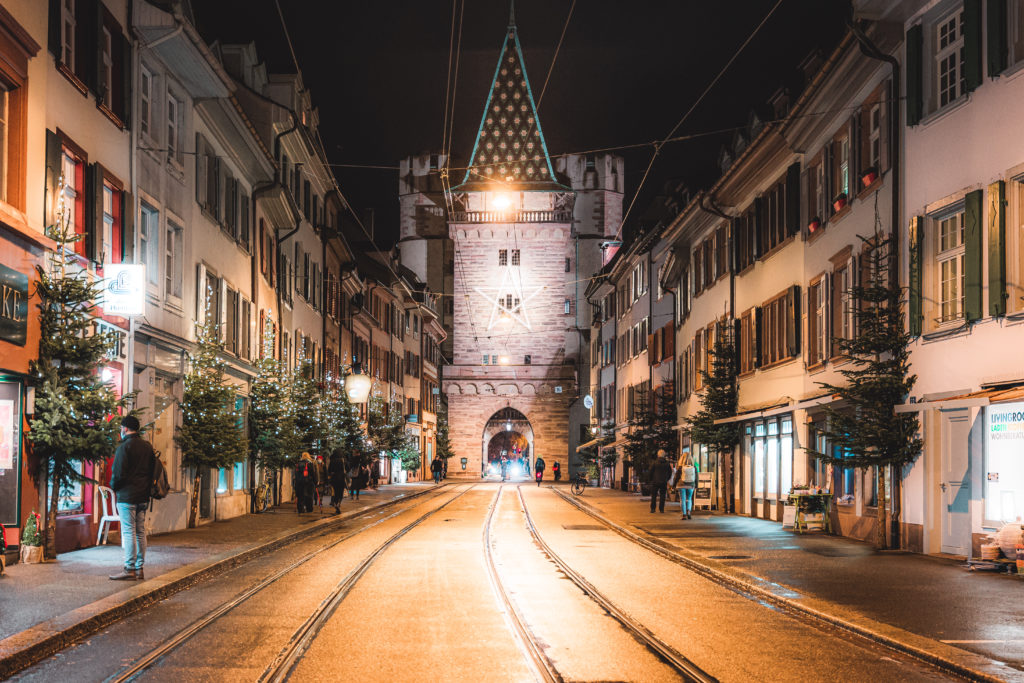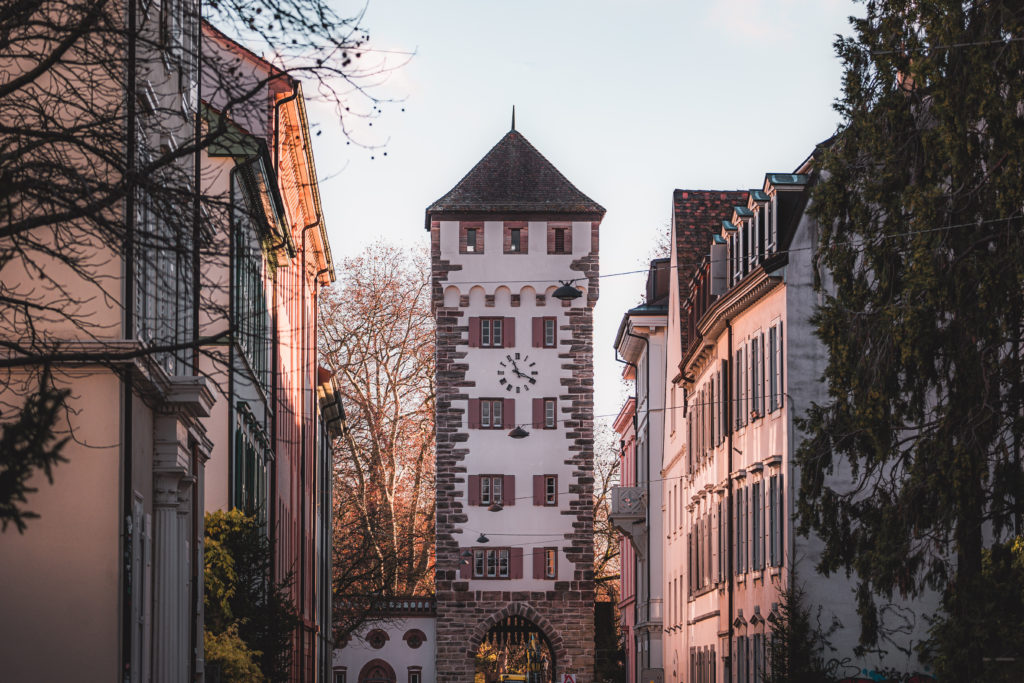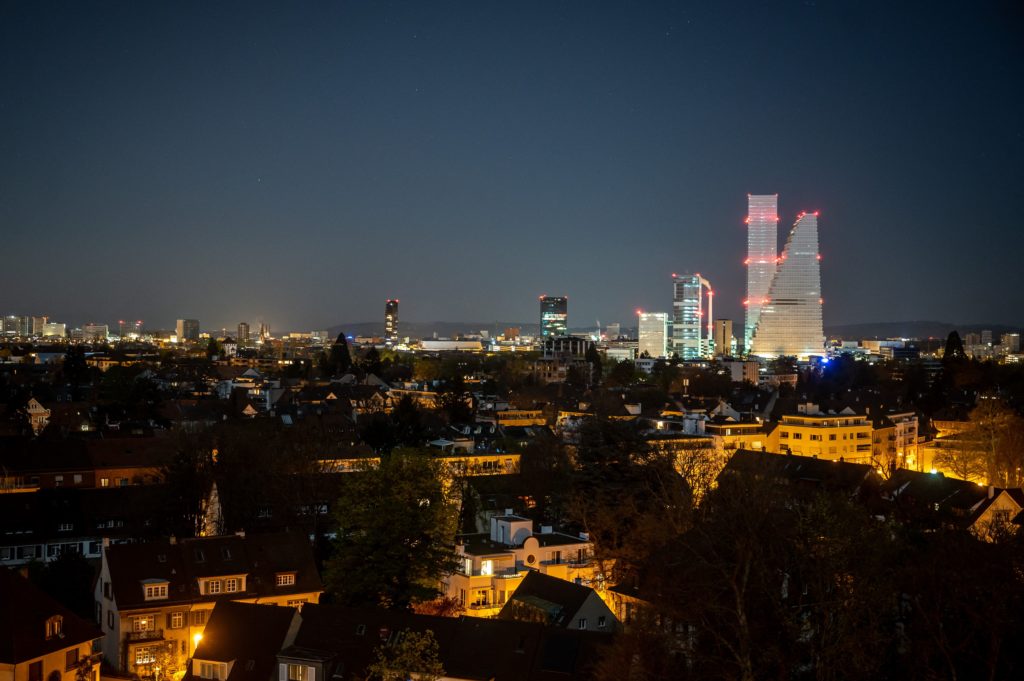MAL ROGERS heads to the historic city of Basel
 The tram line leading to the Spalentor Gate
The tram line leading to the Spalentor GateTHE Eurovision Song Contest 2025 will be held in Basel, Switzerland in May 2025. Fortunately, it’s an easy destination to get to. It’s not only a main transport hub, it’s also a relaxed, eco-friendly city to navigate — on water and land.
The city sits on the banks of the Rhine. This storied river at one time marked the boundary between Romans and Germanic tribes; in days gone by it was the dividing line between Christianity and paganism, between civilisation and barbarism, between the cultured world and the ultramontaine. Oh, and another thing: it’s the dividing line between Basel’s glitzy part with fancy restaurants and what-nots, and its other part where you can get a very good sausage.
Grossbasel to the south is basically upmarket Basel, with showy shops, glamorous restaurants and shimmering fashion houses. To the north, Kleinbasel is full of ethnic eateries, laid back nightlife — oh, and two other countries. Both Germany and France are within a three-kilometre radius. Apparently there's a pub where you can drink in Switzerland and pee in Germany. I doubt if you need your passport.
In Basel, the Rhine makes a wide turn as it flows sedately by. In the summer, locals swim home after work — the commercial centre is upriver of most residential areas. So when workers finish for the day they pack their clothes and belongings into a waterproof Wickelfisch bag and plunge into the Rhine. Their flotation doo-daas bob along behind them as they float or swim home. Increasingly, visitors have also begun to plunge into the dark waters — and it’s certainly an option that Eurovision contestants can take.
The most popular stretch for diving into the Rhine — if you’re not specifically commuting — is between the Schwarzwald and Johanniter bridges. The current then takes you downstream. You can even get a map (waterproof of course) – of the best swimming routes. So if you see someone brandishing a piece of paper while swimming along, they’re not waving, they’re not drowning: they’re trying to read their map.
Large flat-bottomed barges share the water with swimmers. Some are very business-like, others are festooned with flowers and fairy lights, and with bicycles strapped to their railings. But relax — the commercial traffic is kept well away on the other side of the Rhine.
The current of the river also provides another very green mode of transport. To find it, head for the mediaeval St Johann’s Gate, and a riverside path will take you to the 13th century Mittlere Rheinbrücke (middle bridge). The cable ferry is just by the bridge; www.faehri.ch is the website. Better still, just press the bell and the ferry will head, crab-like, across the river. Affixed to an overhead cable, propulsion is entirely by the current of the Rhine: in both directions, seemingly in defiance of the laws of physics.
You could, of course, choose to cycle. That’s what the research chemist Dr Albert Hoffman decided to do one dreary Friday afternoon in 1943. Picture, if you will, Dr Hoffman working in one of Basel’s pharmaceutical companies experimenting on fungus, hoping to extract a cure for migraine.
Feeling a bit odd, he decides to call it a day. He makes his way across the Rhine, which makes a left hand-turn at Wettstein. He heads into the Old Town, through the 700-year-old Spalentor gate tower, and past the elegant 16th century Town Hall. But he sees none of these architectural delights. Instead his eyes are assailed by "an uninterrupted stream of fantastic pictures . . . a kaleidoscopic play of colours." Soon, he reports, “I perceived an uninterrupted stream of fantastic pictures, extraordinary shapes with intense, kaleidoscopic play of colours.” In fact, what our Albert had discovered wasn't a cure for migraine at all, but LSD.
Don’t try this one at home folks.
Albert Hoffman, by the way continued his studies into hallucinogenic drugs. His team isolated, named and synthesized the principal psychedelic mushroom compounds psilocybin and psilocin. As it happens, Albert lived till he was 102. There must be a lesson in there somewhere, but I’m dashed if I can see it.
 St. Alban Gate (pic Basel Tourismus)
St. Alban Gate (pic Basel Tourismus)TRAVEL to Basel is fairly easy. And if you’re tired of plane-shaming and want to do some train-bragging to show your green credentials, no better place. You can get to the centre of Basel from the centre of London in less than seven hours. Rail Europe is advertising fares for around £43, but about £100 seems to be more common. It’s not as cheap as flying, but it has two benefits. (1) You’re helping to save the planet and (2) you pass perhaps the most famous signal box in the world, the Zentralstellwerk. This Basel building was designed by A-lister architects Herzog and de Meuron of Tate Modern fame. The shimmering, rust-coloured monolith, six storeys high and sheathed in horizontal copper strips, can be spotted from your train (right hand side as you enter Basel station) or can be viewed from the Munchensteiner railway bridge. I can anorakly confirm that this is a signal triumph in the world of railways.
The great thing about travelling by rail is you arrive in the centre of town. In Basel you pick up a tram outside the Hauptbahnhof. They rattle and sway along ancient tracks (more than a century old), delivering you to pubs, clubs, shops and a bewildering range of museums. They even visit the other two adjacent countries, France and Germany, making this the only international tramway system in the world.
The Basel trams are of the vintage that allows you to travel to quintessential Mittel Europa. Staring out the window you soon enter a world of 1950s film-noir: cobbled streets, timber-framed shops and houses, honeycombed mediaeval alleyways that seem designed for furtive meetings.
You expect Greta Gardo to get on at every stop.
I was on the line 8199 from Basel central station, heading for Schifflände. I would get off there, bid Greta good day, and head for my accommodation — Le Grand Hotel Les Trois Rois.
 Basel at night (Photo by FABRICE COFFRINI/AFP via Getty Images)
Basel at night (Photo by FABRICE COFFRINI/AFP via Getty Images)THIS old inn, dating back to 1026, has been midwife to momentous ideas. The eponymous kings, Les Trois Rois in fact - Emperor Conrad II, Heinrich III, and Rudolf III of Burgundy - booked B&B here to thrash out matters of sovereignty. Evidently a fruitful meeting, as the citizens of Switzerland - basically a bunch of German, Italian and French hill-farmers clinging to a mountain range - subsequently became the richest nation on earth. Neutrality, they realised was key to financial success. An interesting website sums p countries in one sentence or two. Russia’s for instance is: “And then things got worse.” Switzerland’s is more uplifting” “Thinking of having a war? Let us hold your wallet.”
Not surprisingly most of the crowned heads of Europe have crashed at LTR, obviously a fecund place for scheming. It was while standing here on a balcony gazing down on the Rhine that Theodor Herzl came up with his Big Idea: a new state called Israel.
Even if nation-building ain’t on your mind, you could still order up a Bellini, sink into a sumptuous sofa and think great thoughts. Perhaps even come up with the odd imponderable yourself: like, how come in this land of chocolate and cheese in gargantuan portions the citizens are amongst the classiest-looking and most svelte in Europe?
It just doesn't seem fair.
Where to visit
The Cathedral
The Münster, Basel Cathedral, resplendent in red sandstone and black granite, dominates the city from its soaring Rhineside terrace. Built in Romanesque and Gothic styles, its viewing platform looks northeards across the Rhine to the Black Forest in Germany. From the Münsterplatz steep lanes thread down through leafy courtyards, past mediaeval churches and cosy inns. You see, Switzerland's non-qualification for the big events of 1914-18 and 1939-46 left its cities largely intact.
Augustinergasse will bring you into the into the city centre, to the terracotta-red 16th century Rathaus
The art galleries and museums
Basel is the art centre of Switzerland. The Kunstmuseum was the first collection of art accessible to the public in the world (back in 1661). Head straight there if Holbein is your hobby — the Kunstmusem holds the world’s biggest collection of his work
Beleyer Fondation, Baselstrasse 101, designed by Italian architect Renzo Piano, houses a world-class collection featuring the likes of Peace Through Chemistry by Lichtenstein, or Nu Bleu by Matisse (you'll know them alright). If you've only got time for one exhibit, charge in and have a butcher's at Monet's Water Lilies in a room eponymously looking out over a lake with real water lilies. There are also works by Picasso, Matisse, Giacometti and Warhol.
Tinguely Museum, Paul Sacher-Anlage 1
Featuring the kinetic sculptures of Jean Tinguely, your first reaction may well be that here was a man who was evidently barking. Unbelievably complex machines equipped with huge pulleys, pistons, cogs and coiled springs do nothing more than, for instance, wave a feather or make a mechanical teddy bear nod his head. Whether the almost comically rude box office staff are part of the exhibition I never quite worked out.
Dine on the Rhine
Top choice would be Chez Donati, a five minute walk along the Rhine riverbank from Les Trois Rois. Just by the Johanniterbrücke, the restaurant serves traditional Italian-Swiss food. Switzerland is made up of German, French, Italian and Romansh people and they know their way round a cheese fondue. With brandy in it, if you please. This is a place for those with a flexible take on diets.
 Basel does winter very well (pic Basel Tourismus)
Basel does winter very well (pic Basel Tourismus)With thanks to Le Grand Hotel Les Trois Rois www.lestroisrois.com/en
and to Basel Tourismus
Switzerland Tourism myswitzerland.com

